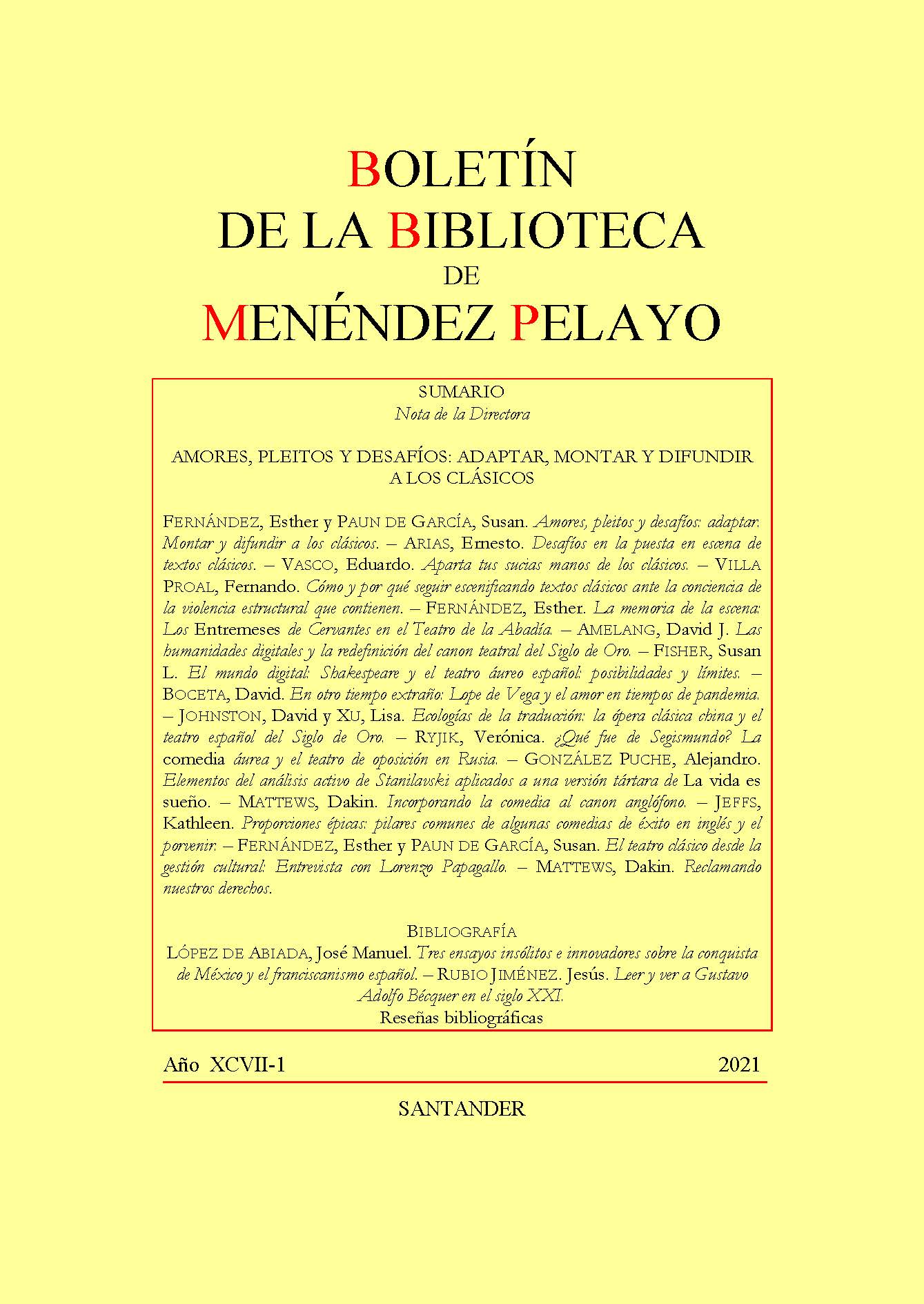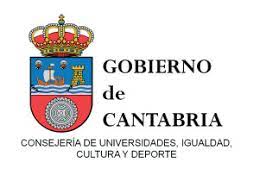Ecologies of translation: Chinese classical opera and Spanish Golden Age Theatre
DOI:
https://doi.org/10.55422/bbmp.441Palabras clave:
Traducción, Representación, Recepción, Barroco, AfectividadResumen
Este artículo examina una tarea clave del traductor, que es identificar las «affordances», o prestaciones, de los contextos receptores en los que el texto traducido puede prosperar como obra independiente. El artículo sugiere que nuestro creciente interés contemporáneo en lo que podríamos denominar el retorno del espíritu del barroco como estética escénica proporciona un marco significativo para realizar el potencial en inglés tanto de las obras de teatro del Siglo de Oro español como de las óperas clásicas chinas. Ambas formas, en mayor o menor medida, se han visto atrapadas en un punto muerto de unicidad nocional, en el sentido de que muchos críticos, traductores y, en el caso de las óperas clásicas chinas en particular, el peso de la interpretación nacionalista, insisten en la reverencia textual más que su posible presencia poderosa en el escenario extranjero. Dicha presencia, de ambas formas, se construye a base de la energía direccional sostenida de la emoción como principal agente de la participación por parte del público. Tal emoción, está claro, no excluye el pensamiento, sino que lo inserta dentro del poder afectivo general que tanto la comedia como la ópera china innegablemente ejercen en el escenario.
Descargas
Publication Facts
Reviewer profiles N/D
Author statements
Indexado: {$indexList}
- Academic society
- Sociedad Menéndez Pelayo
- Editora:
- Sociedad Menéndez Pelayo
Estadísticas globales ℹ️
|
447
Visualizaciones
|
226
Descargas
|
|
673
Total
|
|
Citas
AGAMBEN, Giorgio. (1998). Homo Sacer: Sovereign Power and Bare Life. Daniel Heller-Roazen (Trad.) Redwood City (CA). Stanford University Press.
BARNETT, Laura. (2013). «National Theatre: Do Audience Responses Play Out Along Country Lines?» The Guardian. https://www.theguardian.com/stage/2013/jul/12/nationality-theatre-country-audience-response
BATAILLE, Georges (1962). Death and Sensuality: A Study of Eroticism and the Taboo. New York. Walker and Co.
BATTEY, Robert. (2014). «Peking Opera at Kennedy Center Has the Right Moves, if Not the Best Sounds». The Washington Post. https://www.washingtonpost.com/entertainment/theater_dance/peking-opera-at-kennedy-center-has-the-right-moves-if-not-the-best-sounds/2014/08/28/6a0e5760-2ecf-11e4-be9e-60cc44c01e7f_story.html
BENTLEY, Eric. (1968). Life of the Drama. London. Methuen.
-----. (1970). «The Comedia: Universality or Uniqueness? ». Hispanic Review 38.2. 147-173. DOI: https://doi.org/10.2307/471888
BROCKETT, Oscar, and Franklin HILDY. (2008). History of the Theatre. Boston. Pearson.
CHINA CULTUAL CENTRE. (2019). https://msmy.facebook.com/cccsingapore/posts/1614167582061395
CALDERÓN DE LA BARCA, Pedro. (1995). The Painter of Dishonour. David Johnston y Laurence Boswell (Trans.) London. Oberon.
FELSKI, Rita. (2015). The Limits of Critique. Chicago. University of Chicago Press. DOI: https://doi.org/10.7208/chicago/9780226294179.001.0001
FISCHER-LICHTE, Erika. (2014). «Introduction». The Politics of Interweaving Performance Cultures: Beyond Postcolonialism. Erika Fischer-Lichte, DOI: https://doi.org/10.4324/9781315858142
Torsten Jost y Saskya Iris Jain. New York, London. Routledge. 1-21.
GIBSON, James J. (1979). The Ecological Approach to Visual Perception.Hove. Psychology Press.
GIL-OSLE, Juan Pablo y Frederick A. DE ARMAS, eds. (2019). Faraway Settings: Spanish and Chinese Theaters of the 16th and 17th Centuries. Madrid, Frankfurt. Iberoamericana Vervuert. DOI: https://doi.org/10.31819/9783964568922
GOLDSTEIN, Joshua. (2007). Drama Kings: Players and Publics in the Re-creation of Peking Opera. Berkeley, Los Angeles, London. University of California Press. DOI: https://doi.org/10.1525/9780520932791
GUAN, Hanqing. (1958). Selected Plays of Guan Hanqing. Xianyi Yang and Yang Gladys (Trans.) Beijing. Foreign Languages Press.
GUNDERMANN, Karsten. (2010). Le Cinesi. https://www.lartedelmondo.de/index.php%EF%B9%96id=87&L=1&tx_ttnews%5Btt_news%5D=20&cHash=7c596773fd3087e9f828d32518e26b83.html
HARE, David. (1991). Writing Left-Handed: Collected Essays. London. Faber and Faber.
HONG, Shen. (1959). [Nuestra traducción: The «Lady Precious Stream» that Humiliates China] ». In S. Hong, [Nuestra traducción: The Collection of Hong Shen's Works]. Beijing. Chinese Theatre Press. 244-253.
HUTCHEON, Linda. (2012). A Theory of Adaptation. New York, London. Routledge. DOI: https://doi.org/10.4324/9780203095010
JOHNSTON, David. (2007). «Historicising the Spanish Golden Age: Lope’s El perro del hortelano and El caballero de Olmedo in English». The Spanish Golden Age in English. Catherine Boyle and David Johnston (Eds.) London. Oberon. 50-51.
KAUP, Monika. (2018). «Feeling Baroque in Art and Neuroscience: Joy, Sadness, Pride, and a Spinozist Solution to the Quest for Happiness». Emotion and the Seduction of the Senses, Baroque to Neo-Baroque. Lisa Beaven y Angela Ndalianis (eds.) Kalamazoo. Medieval Institute Publications. DOI: https://doi.org/10.2307/j.ctvd1c8n2.7
KENNEDY, Dennis. (1993). «Introduction». Foreign Shakespeare: Contemporary Performance. Cambridge. Cambridge University Press. 1-18.
LAMBERT, Gregg. (2004). The Return of the Baroque in Modern Culture. London. Bloomsbury. DOI: https://doi.org/10.5040/9781472545954
LI, Jingrong. (2012). «Peking Opera, now fully translated in English». China.org.cn. http://www.china.org.cn/arts/2012-10/24/ content_26888597. htm
LI, Ruru. (2010). The Soul of Beijing Opera: Theatrical Creativity and Continuity in the Changing World. Hong Kong. Hong Kong University Press.
MACCOLL, Ewan. (1986). «Introduction». Agit-prop to TheatreWorkshop: Political Playscripts 1930-1950. Manchester. ManchesterUniversity Press. 1986. xxxxix-xi.
MACLEISH, Archibald. (1952). Collected Poems: 1917-1952. Boston.Houghton Mifflin Harcourt.
MARCUSE, Herbert. (2007). Art and Liberation: Collected Papers ofHerbert Marcuse. New York, London. Routledge. DOI: https://doi.org/10.4324/9780203966617
MARTIN, John Rupert. (2018). Baroque. London. Routledge. DOI: https://doi.org/10.4324/9780429502125
PARKER, A. Alexander. (1958). «The Approach to the SpanishDrama of the Golden Age». The Tulane Drama Review 4.1. 42-59. DOI: https://doi.org/10.2307/1124804
PATERSON, A.K.G. «Preface». (1991). Pedro Calderón de la Barca: The Painter of His Dishonour, El pintor de su deshonra. A.K.G. Paterson (Trans.) Warminster. Aris and Phillips.
PAZ, Octavio. (1987). Convergences: Essays on Art and Literature. New York. Harvest.
REICHENBERGER, Arnold. (1959). «The Uniqueness of the Comedia». Hispanic Review. 38. 2. 147-173. DOI: https://doi.org/10.2307/471021
SELMAN, Chris. (2019). «Peking Opera Company Present Stunning but Challenging Programme at Sadler’s Wells». Gay Times. https://www.gaytimes.co.uk/culture/peking-opera-company-present-stunning-but-challenging-programme-at-sadlers-wells-review/
SLOTERDIJK, Peter. (2011). Neither Sun nor Death. Steve Corcoran (Trad.). Cambridge. MIT Press.
-----. (2014). Globes: Spheres II. W. Hoban (Trans). Cambridge. MIT Press.
SONTAG, Susan. (1966). Against Interpretation and Other Stories. New York. Noonday Press.
SWATEK, Catherine. (2002). «Boundary Crossings: Peter Sellars's Production of Peony Pavilion». Asian Theatre Journal 19.1. 147-158. DOI: https://doi.org/10.1353/atj.2002.0017
SWED, Mark. (2000). «A Short Trip to The Peony Pavilion». Los Angeles Times.https://www.latimes.com/archives/la-xpm-2000-jan-17-ca54744-story.html
TANG, Xianzu. (2002). The Peony Pavilion: Mudan Ting. Cyril Birch (Trans.) Bloomington. Indiana University Press.
VEGA, Lope de. (1990). The Dog in the Manger. Victor Dixon (Trans.). Ottawa. Dovehouse.
-----. (2004).The Dog in the Manger. David Johnson (Trad.).London. Oberon Books.
-----. (Nov. 2017) The Agony and the Style. David Johnston (Trad.). Performed Richard Burton Theatre, Royal Welsh College, Cardiff.
WANG, Shifu. (1968). The Romance of the Western Chamber. S. I.Hsiung (Trad.). New York. Columbia University Press.
WICHMANN, Elizabeth. (1990). «Tradition and Innovation in Contemporary Beijing Opera Performance». The Drama Review. (1988) 34.1. 146-178. DOI: https://doi.org/10.2307/1146013
WILLIAMS, Raymond. (1998). «The Analysis of Culture». Cultural Theory and Popular Culture: A Reader (Second Edition) John Storey (Ed.) Athens. The University of Georgia Press.
YAO, Yuan. (2013). Our Translation: Dream in the Garden Volume II. https://artist.artron.net/yishujia0007065/2-7970.html
YEH, Diana. (2014). Happy Hsiungs: Performing China and the Struggle for Modernity. Hong Kong: Hong Kong University. DOI: https://doi.org/10.5790/hongkong/9789888208173.001.0001
Descargas
Publicado
Cómo citar
Número
Sección
Licencia
Derechos de autor 2022 David Johnston, Lisha Xu

Esta obra está bajo una licencia internacional Creative Commons Atribución-NoComercial 4.0.







